Philips Cinema 21:9 56PFL9954H 56in LCD TV Review
Philips Cinema 21:9 56PFL9954H 56in LCD TV
Find out why John thinks the Philips Cinema 21:9 LCD TV has to be seen to be believed.
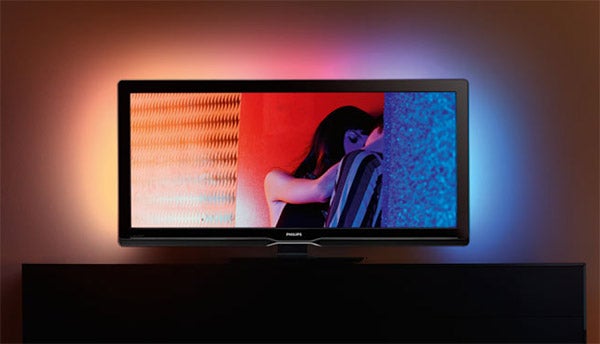
Verdict
Key Specifications
- Review Price: £4500.00
If there’s one thing I get asked about more than anything else in my capacity as a bloke who gets to spend an obscene amount of time with untold numbers of TVs, it’s black bars. You know, the ones that sit above most films you watch at home these days.
People invariably hate them, especially when they appear on a widescreen TV, largely because they assume that’s the whole reason companies started building widescreen TVs in the first place; so that films could be watched without black bars around them. They just don’t realise that not all films are made the same.
For while some are shot using an aspect ratio (image width:image height) very close to that presented by a 16:9 TV, and so can appear without black bars, most are filmed using a much wider aspect ratio, such as 2.35:1 or 2.40:1. And so if you want to watch these films at home as the director intended, with no missing picture information, you have to put up with black bars to top and bottom, ”even” on a widescreen TV. 
Or at least, you did have to until today. For sprawling across the wall in front of me is Philips’ Cinema 21:9 TV – a set that quite literally changes the shape of the UK TV market.
The clue, of course, is in the title. The big trick of this revolutionary TV is that it carries a 21:9 (2.39:1) aspect ratio rather than the usual 16:9, which means it’s tailor made to show 2.35:1/2.4:1 films without having to put black bars above or below them. For the first time ever, such films can fill the entire screen area without having to look out of proportion or having parts of the image pushed out of frame.
As you might expect, the aesthetic impact of a 21:9 aspect ratio makes the Cinema 21:9 look completely unlike any TV you’ve seen before. Its extra width – stretched to a 56in diagonal size – seems much better suited to our horizontally-biased view of the world than a normal 16:9 TV. And so the Cinema 21:9’s pictures seem to fill your field of vision much more completely and, crucially, immersively than those of a normal widescreen TV.
This sense of immersion is further enhanced by the TV’s carriage of Philips’ latest Ambilight Spectra 3 system, whereby light coloured to match the colour content of the source image spills appealingly – and uncannily accurately – out of the TV’s sides and top edge.
Let’s not forget, either, that the Cinema 21:9 is delivering what really does feel like acres of extra screen size without adding substantially to the typical height of a much smaller normal widescreen TV, meaning that it dominates your field of vision without overwhelming your room quite as much as you might expect.
The strangest thing of all about the Cinema 21:9 aesthetically, though, is the way its extra width just somehow feels right, for want of a more technically accurate explanation. The glossy black finish and gently rounded corners of the set’s bezel are attractive in themselves, certainly. But they’re not enough to explain the chorus of ‘oohs’ and ‘aahs’ that invariably escaped from the mouths of anyone I showed the TV to while I was testing it. It’s as if the TV’s very shape seems to make it instantly more attractive. 
Given that the Cinema 21:9 is clearly established as the flagship model in Philips’ latest TV range, it’s no surprise to find its elongated rear panel absolutely heaving with connections. Highlights of what’s on offer include a stonking five HDMIs (one down the TV’s side), a dedicated D-Sub PC port, a USB port that can play back all sorts of different multimedia file formats, and an Ethernet port which, happily, can be used either for accessing files from a networked, DLNA-certified PC, or for accessing Philips’ new online service. Even better, you can access the Internet service wirelessly, if you like, via the TV’s built-in Wi-Fi system.
Philips’ online service is currently unique among mainstream TV brands for offering you two options: 1) access to Philips’ own managed content, designed specifically to work with a standard TV operating system, and 2) access to the world wide web at large. I won’t go into more detail on all this here as I covered it at length in the recent review of Philips’ 32PFL9604. But suffice it to say that the system is very polished in its presentation, and even the full Internet access isn’t as tricky to handle via the TV’s remote as you might anticipate.![]()
Given the amount of features Philips likes to throw at even its relatively mid-range TVs, it’s no surprise at all to find the Cinema 21:9’s onscreen menus almost overwhelmed with stuff. Occupying the lion’s share of the options, of course, is the TV’s video processing. For driving the screen is the latest version of Philips’ extremely powerful Perfect Pixel HD engine, with its Perfect Natural Motion, Perfect Contrast and Perfect Colours components – all of which can be tinkered with to within an inch of their lives to suit your individual tastes.
That’s far from the end of the video processing story, though. For also extremely eye-catching is the appearance of Philips’s first 200Hz engine, created by combining 100Hz processing with a scanning backlight running at a 50 per cent duty cycle. Hopefully this will further enhance the extensive impact on reducing motion blur and judder delivered by the Perfect Natural Motion system.
One final picture processing area I simply have to talk about is one that I normally don’t bother getting involved with: aspect ratio controls. For the fact is that to some extent the Cinema 21:9 will stand or fall on how well its aspect ratio handling works. Why? Because wouldn’t you just know it, recreating 2.35:1/2.4:1 films without black bars on the Cinema 21:9’s screen isn’t nearly as straightforward as you would probably imagine.
The problem is that when 2.35:1 films are broadcast or encoded onto Blu-ray, the black bars necessary to make the source work with a 16:9 TV are built into the actual source picture. In other words, the black bars aren’t created by your TV, but rather added, line by line, to the source, as if they were parts of the main image.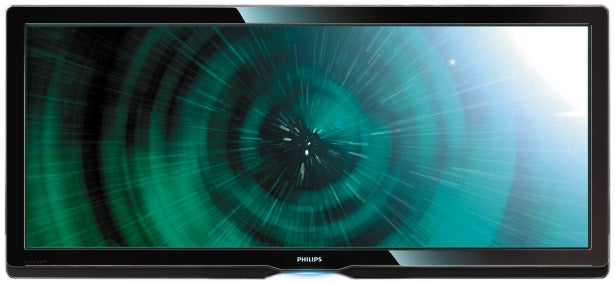
In order to make today’s 2.35:1 films fill its screen, therefore, the Cinema 21:9 has to remove these bars from sources, using sophisticated processing to ‘blow them up’ so that they’re pushed off the top and bottom of the screen, while the rest of the image appears both intact and with its natural proportions.
This sort of talk is enough to potentially send shudders down any die-hard AV aficionado’s spine. For if there’s one thing such people tend to hate, it’s the thought of a TV’s processors ‘interfering’ with the image that’s coming in from a source. After all, one of the reasons Full HD TVs have been such a hit is their ability to reproduce normal 1,920 x 1,080-pixel, 16:9 sources on a direct pixel by pixel basis, without having to use processing to rescale the source image to a different resolution.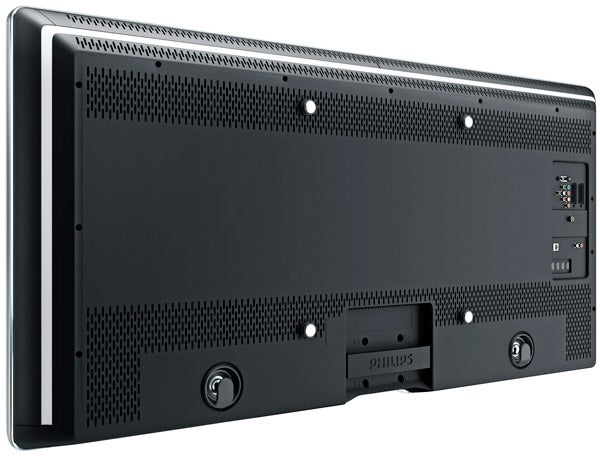
Yet since there are no sources currently available able to match the Cinema 21:9’s native 2,560 x 1,080 pixel count, the TV obviously has to use processing to add in the extra pixels necessary to translate a 1,920 x 1,080 – or 576 PAL, come to that – source to its unprecedented resolution. Hence my belief that the quality of the TV’s image scaling processing is arguably the single most important factor in its success or failure.
From the previous paragraphs, it’s clear that what this TV is really crying out for is native 21:9 film masters. And actually, there is no reason at all why Blu-ray manufacturers can’t provide a native 21:9, 2,560 x 1,080 version of a 2.35/2.4:1 film on a Blu-ray disc rather than a 16:9 version with added bars. The potential for 21:9 is certainly built into the Blu-ray spec.
At the time of writing, though, Philips hasn’t managed to persuade any film studio to support this. There’s still vague talk of future discs that might carry native 21:9 transfers, but it would have really helped turn on tech-heads if there had been even one actual 21:9 disc available to accompany the TV’s launch.
In the absence of such a ‘holy grail’ film transfer, though, I’m very relieved indeed to be able to report that the Cinema 21:9’s various processing systems do a remarkably good job of handling the challenges that ‘going 21:9’ creates.
Actually, that rather cold statement doesn’t even start to do justice to what watching a selection of 2.35:1-ratio Blu-rays on the Cinema 21:9 really feels like. Much more emotive words like ‘mesmerising’, ‘entrancing’ and ‘jaw-dropping’ would be closer to the mark.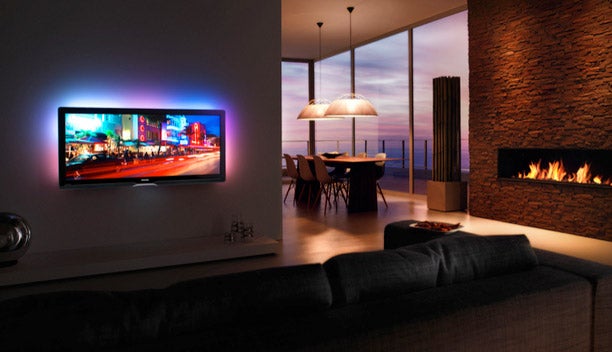
Seeing, for instance, the 2.35:1 image from our much-hammered ”Casino Royale” Blu-ray completely filling the Cinema 21:9’s screen without a black bar or wasted pixel in sight has to go down as a genuine Eureka moment. A moment that makes you wonder both why nobody has done a TV like this before, and how you’re going to go back to watching films on your boring old 16:9 TV.
Cynics will perhaps think I’m going rather overboard here, suspecting that things can’t really be all that different from watching a 2.35:1 film on a big, normal widescreen TV with black bars above and below it. But all I can say to you is that somehow, for reasons I’m not sure I can even articulate fully, seeing a 2.35:1 image perfectly contained within a 21:9 frame just feels much more exciting, natural and engrossing than watching such an image with black bars above and below, and a frame that doesn’t fit it properly.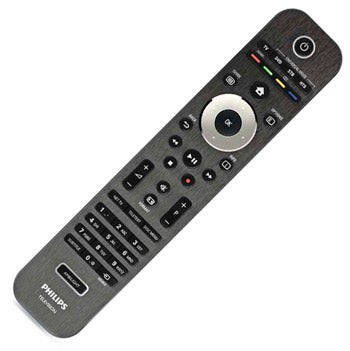
Part of this, I suspect, has to do with the fact that by fitting precisely around the image it’s showing, the Cinema 21:9 does a much better job of making you forget that you’re watching a bit of AV technology, leaving you free to get more directly involved with the film.
The lack of any black bars also delivers an unexpectedly significant benefit with the Ambilight system. For the Ambilight effect seems much more organically connected with the picture when you haven’t got black bars of empty image data lying between the picture and the light coming out of the TV’s edges.
I would say, too, that you shouldn’t underestimate the impact on perceived screen size that the shift to 21:9 brings. For while the Cinema 21:9’s 56in quoted screen size might not sound all that spectacular on paper, in the flesh the extra width makes it look absolutely huge. Obviously I’d still love Philips to come up with a 70in version next (!), but honestly, the 56in size is more than enough for any living room, and actually probably enough for many dedicated home cinema rooms.
All this talk of how natural and immersive the Cinema 21:9 experience is would not hold true, of course, if there were significant failings with the processing that makes it all possible. In fact, the stunning naturalness of the 21:9 aspect ratio would make any nasty processing side effects all the more glaring and therefore intolerable.
But provided you take a few simple precautions, the bottom line is that the Cinema 21:9 rescales pictures to take advantage of its unique resolution more cleanly than I’d frankly thought possible.
Rescaled HD sources, for instance (even native 16:9 ratio ones!), still look outstandingly sharp and detailed, with little if any of the softening and edge blurring that often accompanies significant rescaling processes. Colours, meanwhile, lose not a trace of authenticity or accuracy in the rescaling process, overcoming another common rescaling issue. In fact, for my money the Cinema 21:9’s colours are among the most natural, subtle yet also superbly vibrant that I’ve ever seen on a non-LED LCD TV.
Perhaps most remarkable of all is the way the TV manages to add in all the necessary pixels of image data it needs to without making the image look grainy or alive with dot crawl – especially if you keep the contrast setting no higher than 80 and leave on the unusually intelligent noise reduction system (the normal one, not the MPEG one), set to its Low level. 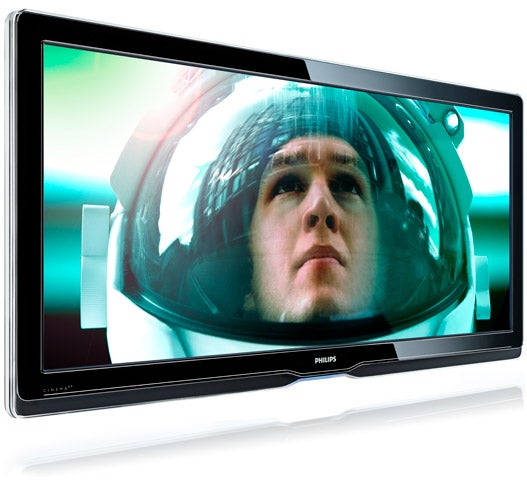
Normally, it must be said, I wouldn’t dream of using noise reduction on an HD source, for fear of softening the picture. But the NR system here works beautifully in reducing any slight coarseness that might occur, without substantially reducing the amount of texture and detail in the image.
Add to all the fabulous stuff mentioned so far the fact that the Cinema 21:9 produces some of the deepest black levels I’ve seen on a Philips LCD screen (not counting its LED model) and suffers remarkably little with motion blur, even without the HD Natural Motion system turned on, and you’re talking about the single most cinematic viewing experience I’ve ever experienced on a telly. Seriously.
While this sort of spectacular HD performance is clearly the Cinema 21:9’s bread and butter, it’s also a much more able handler of standard definition, 16:9 sources than expected. All but the very lowest quality digital 16:9 broadcasts can be stretched to fill the 21:9 screen with startling aplomb, suffering much less with softness and emphasis of source noise than anticipated. And no, the stretching process doesn’t leave everyone on screen looking unfeasibly short and fat!
It’s a bit annoying, I guess, that the TV doesn’t seem to provide an option that expands 16:9 sources to 21:9 without pushing a bit of the image’s top and bottom edges off the screen. And I’d say you’re better off leaving poor-quality sources set to their native 16:9 ratio (the option is provided for this) so that they appear with black bars down their left and right sides than trying to push them to the screen’s maximum width. But for the most part you really can get ordinary TV shows using all of the TV’s pixels without them looking in the least bit nasty.
Problems with the picture do certainly exist. My biggest issue is with the HD Natural Motion system. For while this does a strikingly potent job of making motion look more fluid and sharp, it also creates noticeable flickering artefacts, and some signs of distortion around the edges of moving objects.
In fact, I actually felt that these artefacts were more obvious than on other recent Philips sets I’ve seen, either because of the screen’s sheer size, or because of the extra processing burden raised by the challenge of adjusting sources to the Cinema 21:9 screen. And as I noted earlier, anything obviously distracting becomes all the more intolerable when the rest of the Cinema 21:9 experience is so immersive.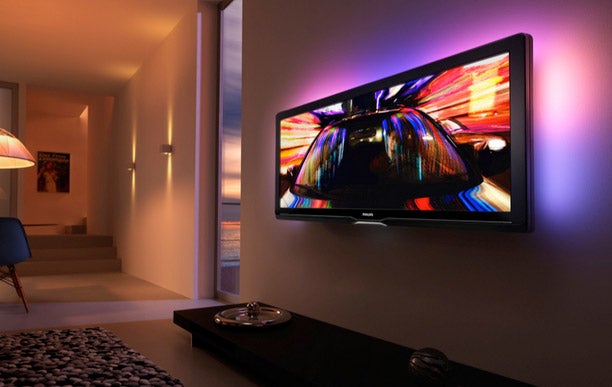
I’ve already noted the TV’s slight aspect ratio flaws with standard definition sources, and I found a minor issue with Blu-rays too, where by if I called up the Blu-ray player’s own built-in system graphics while watching a 2.35:1 film, the Cinema 21:9’s generally clever Auto Format mode would mistake the image content for subtitles, and so adjust the picture so that small black bars suddenly appeared that stayed there for a considerable time unless I manually changed the aspect ratio. Finally, the image can lose a little contrast if watched from a wide angle. These issues really are extremely minor, though, in the context of the great viewing experience of the Cinema 21:9.
Moving reluctantly on to the Cinema 21:9’s audio, I suspect there’s a very good chance that most people buying such an expensive TV will have a separate surround sound audio system. But that doesn’t mean that Philips has skimped on its flagship TV’s audio performance. Its speaker system comprises two integrated subwoofers and two dome tweeters, and these allow for levels of bass reproduction and dynamic range separation that’s miles better than anything you’ll hear on a typical flat TV.
”’Verdict”’
I have to say I was pretty sceptical about the Cinema 21:9. My distaste for resizing HD sources, my dislike of distracting video processing artefacts, the current lack of any ‘true’ 21:9 sources and my suspicion that standard def programmes would look awful when stretched to fill the 21:9 frame all left me expecting the TV to be nothing more than an expensive gimmick.
But you can consider me converted. Philips’ video processing powers have turned out to be beyond reproach if you’re careful with a couple of basic settings, leaving you to enjoy a TV experience that’s so cinematic it has to be seen to be believed.
Sure, to some extent this is a TV that’s ahead of its time, waiting for the Blu-ray industry in particular to (hopefully) catch up with it. But crucially it works supremely well even without native 21:9 transfers, and the concept feels more like something inherently natural that somebody should have made years ago rather than something that’s pushing back TV frontiers just for the sake of it.
However. perhaps the biggest obstacle to the Cinema 21:9 achieving world domination is its £4,500 price. A price which could get you a very nice projection system. But all I can say is that if £4,500 is simply beyond the pale for you, for heaven’s sake don’t try and track down a Cinema 21:9 to try out. Because it really is one of those things that once tried is hard to live without.
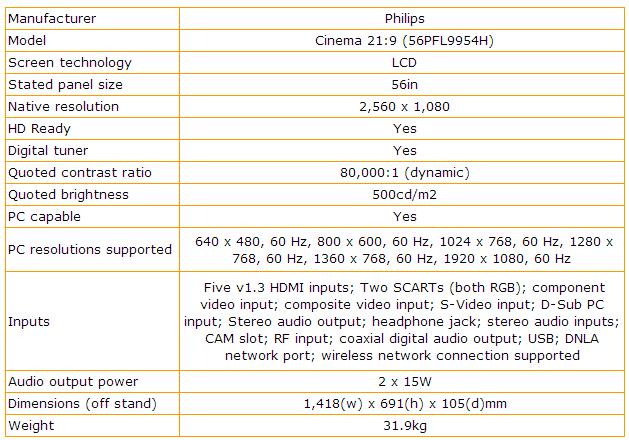
How we test televisions
We test every TV we review thoroughly over an extended period of time. We use industry standard tests to compare features properly. We’ll always tell you what we find. We never, ever, accept money to review a product.
Trusted Score
Score in detail
-
Features 10
-
Value 7
-
Image Quality 9
-
Design 10
-
Sound Quality 9
Features
| Size (Inch) | 56in |
| Display Type | LCD |

